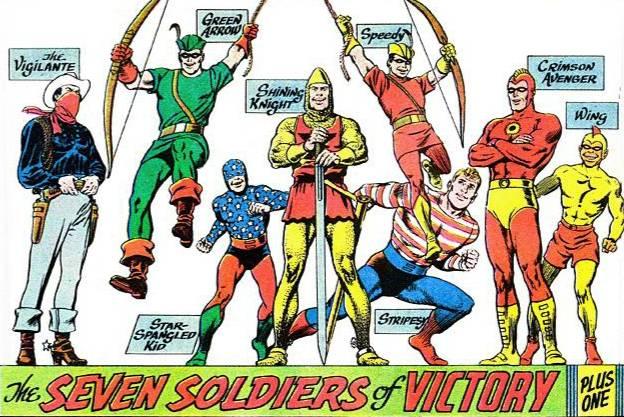Comic Book Confidential: The Seven Soldiers of Victory
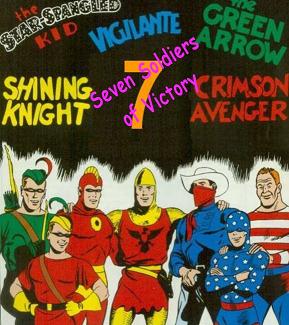 In 1940, DC Comics made comic book history when they created the first true superhero team, the Justice Society of America. The JSA’s initial roster featured the most powerful characters operating at the time in the DC universe like The Spectre, Dr. Fate, Green Lantern and Hourman. Even Superman was listed as an honorary member on the original role call. This was a team designed to handle major disturbances and not a group to be taken lightly.
In 1940, DC Comics made comic book history when they created the first true superhero team, the Justice Society of America. The JSA’s initial roster featured the most powerful characters operating at the time in the DC universe like The Spectre, Dr. Fate, Green Lantern and Hourman. Even Superman was listed as an honorary member on the original role call. This was a team designed to handle major disturbances and not a group to be taken lightly.
The Justice Society team dynamic proved popular and less than a year later, DC decided to try their hand at it again. In much the same way that the JSA had launched All Star Comics (even though they were held back until issue #3), this second team would headline the new title Leading Comics. Unlike the JSA however, this group would be made up of lesser powered characters and used for stories more grounded in reality.
In the fall of 1941, Leading Comics #1 debuted starring a new superhero team, the Seven Soldiers of Victory. The group, alternately referred to as the Law’s Legionnaires, consisted of seven previously established DC heroes who enjoyed respectable solo publishing runs but were beginning to lag in popularity. Before we continue in our discussion of the 7SV, let’s meet the members of the team.
The Crimson Avenger
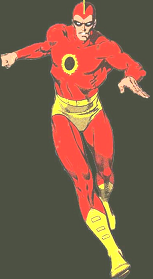 Lee Travis was a wealthy newspaper publisher who became a crime fighter almost by accident after foiling a robbery at a costume party. He was one the earliest superheroes created by DC and preceded Batman by seven issues in Detective Comics. As originally conceived, the Crimson Avenger was a cross between the Shadow and the Green Hornet, wearing a suit, fedora, mask and cape. He possessed no extraordinary powers but was an expert in hand to hand combat and a deadly shot with the twin .45 automatic pistols he carried. Several years later, the Crimson Avenger was given a more traditional red and yellow superhero costume and his Oriental chauffer became his sidekick and unofficial eighth Soldier of Victory, Wing. The Crimson Avenger retired after a long career as a crime fighter but after discovering he was dying of an incurable disease, he returned for one final mission. He foiled a terrorist plot but sacrificed himself to keep a ship loaded with explosives from detonating in a busy harbor and killing innocents.
Lee Travis was a wealthy newspaper publisher who became a crime fighter almost by accident after foiling a robbery at a costume party. He was one the earliest superheroes created by DC and preceded Batman by seven issues in Detective Comics. As originally conceived, the Crimson Avenger was a cross between the Shadow and the Green Hornet, wearing a suit, fedora, mask and cape. He possessed no extraordinary powers but was an expert in hand to hand combat and a deadly shot with the twin .45 automatic pistols he carried. Several years later, the Crimson Avenger was given a more traditional red and yellow superhero costume and his Oriental chauffer became his sidekick and unofficial eighth Soldier of Victory, Wing. The Crimson Avenger retired after a long career as a crime fighter but after discovering he was dying of an incurable disease, he returned for one final mission. He foiled a terrorist plot but sacrificed himself to keep a ship loaded with explosives from detonating in a busy harbor and killing innocents.
The Star-Spangled Kid & Stripesy
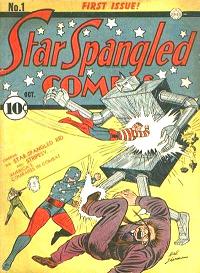 During the height of World War II, young Sylvester Pemberton and Pat Dugan were simultaneously struck by a comment about the American flag coming to life to defend the country. Each created their own patriotic costume and decided to fight crime using their fists and wits. Forming a partnership, Dugan took a job as a chauffer for the Pemberton family; the duo developed a number of routines they would call out by number to catch thugs off guard. Following the events with the Nebula Man which we’ll discuss later, the Star-Spangled Kid was the only one of the 7SV to remain completely active. He joined the Justice Society of America as a junior member in their newly created All-Star Squad and modified some of Starman’s technology to create a cosmic converter belt that enhanced his strength and agility. He would go on to found his own superhero group, Infinity, Inc., comprised mainly of the children and legacies of the JSA but was tragically murdered during one of their missions. Pat Dugan remained in retirement developing a robotic battle suit he dubbed S.T.R.I.P.E. until his stepdaughter took over the mantle of the Star-Spangled Kid. He currently serves as a reserve member of the JSA.
During the height of World War II, young Sylvester Pemberton and Pat Dugan were simultaneously struck by a comment about the American flag coming to life to defend the country. Each created their own patriotic costume and decided to fight crime using their fists and wits. Forming a partnership, Dugan took a job as a chauffer for the Pemberton family; the duo developed a number of routines they would call out by number to catch thugs off guard. Following the events with the Nebula Man which we’ll discuss later, the Star-Spangled Kid was the only one of the 7SV to remain completely active. He joined the Justice Society of America as a junior member in their newly created All-Star Squad and modified some of Starman’s technology to create a cosmic converter belt that enhanced his strength and agility. He would go on to found his own superhero group, Infinity, Inc., comprised mainly of the children and legacies of the JSA but was tragically murdered during one of their missions. Pat Dugan remained in retirement developing a robotic battle suit he dubbed S.T.R.I.P.E. until his stepdaughter took over the mantle of the Star-Spangled Kid. He currently serves as a reserve member of the JSA.
The Shining Knight
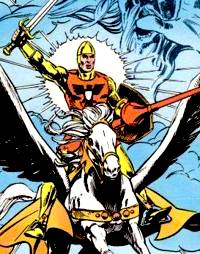 Sir Justin was a genuine knight of King Arthur’s court in medieval England. He gained the favor of the realm and was gifted by the wizard Merlin with a suit of impenetrable armor, a sword that could cut almost anything, and a Pegasus-like horse named Winged Victory. It was most likely this magic armor that protected Justin when he was trapped in an ice avalanche and frozen alive. He was later discovered and revived in the 1940’s where he continued to champion justice in this strange new world. As a member of the Seven Soldiers, Justin was able to provide a unique viewpoint and sensibility to their modern cases as well getting the group out of more than one tight spot with his magic sword. In his civilian life, he was a museum curator under the alias of Justin Arthur. The Shining Knight is still active as a reserve member of the Justice Society of America.
Sir Justin was a genuine knight of King Arthur’s court in medieval England. He gained the favor of the realm and was gifted by the wizard Merlin with a suit of impenetrable armor, a sword that could cut almost anything, and a Pegasus-like horse named Winged Victory. It was most likely this magic armor that protected Justin when he was trapped in an ice avalanche and frozen alive. He was later discovered and revived in the 1940’s where he continued to champion justice in this strange new world. As a member of the Seven Soldiers, Justin was able to provide a unique viewpoint and sensibility to their modern cases as well getting the group out of more than one tight spot with his magic sword. In his civilian life, he was a museum curator under the alias of Justin Arthur. The Shining Knight is still active as a reserve member of the Justice Society of America.
Green Arrow & Speedy
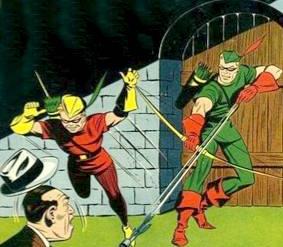 When millionaire playboy Oliver Queen was stranded on a desert island, he survived by creating a makeshift bow and arrows and utilizing his skill in archery. Following his rescue, he decided to take up a career fighting crime as the masked hero Green Arrow. The character was very much a Batman with a bow (and could have easily been called Bowman instead). Like his caped counterpart’s sidekick Robin, Oliver Queen adopted orphan Roy Harper, who already possessed impressive archery skills himself, and trained him as his partner Speedy. The avenging archers fought crime using a variety of specialized arrows that did everything from dropping nets to exploding bombs. Unlike the majority of the Golden Age heroes, Green Arrow and Speedy actually continued being published into the Silver Age. During the Crisis on Infinite Earths, the Golden Age Green Arrow was killed and Speedy seems to have vanished in the merging of the Multiverse.
When millionaire playboy Oliver Queen was stranded on a desert island, he survived by creating a makeshift bow and arrows and utilizing his skill in archery. Following his rescue, he decided to take up a career fighting crime as the masked hero Green Arrow. The character was very much a Batman with a bow (and could have easily been called Bowman instead). Like his caped counterpart’s sidekick Robin, Oliver Queen adopted orphan Roy Harper, who already possessed impressive archery skills himself, and trained him as his partner Speedy. The avenging archers fought crime using a variety of specialized arrows that did everything from dropping nets to exploding bombs. Unlike the majority of the Golden Age heroes, Green Arrow and Speedy actually continued being published into the Silver Age. During the Crisis on Infinite Earths, the Golden Age Green Arrow was killed and Speedy seems to have vanished in the merging of the Multiverse.
The Vigilante
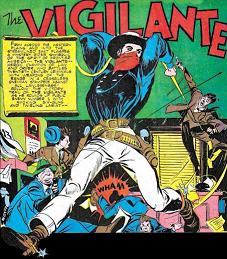 Dispensing old west justice with a modern flare, country singer Greg Saunders became the Vigilante to avenge the death of his Sheriff father. After capturing the killers, he continued his crusade on crime in both the big city and more rural environments. The Vigilante is a crack shot with a six shooter but is almost equally adept with a knife or rope. He was often accompanied by sidekicks, old school cowboy Billy Gunn or the youthful Asian street fighter, Stuff the Chinatown Kid. The post Crisis on Infinite Earths continuity of the Vigilante is the most unstable of any of the Seven Soldiers. Depending on who was writing the story, he has been said to have remained young after the battle with the Nebula Man or accidently lost his youth. In the recent Seven Soldiers of Victory miniseries by Grant Morrison, he was killed in a battle with the Monster of Miracle Mesa but then returned to life because he had become a werewolf years earlier! He was later shown to have returned to the old west and become Sheriff of a small town.
Dispensing old west justice with a modern flare, country singer Greg Saunders became the Vigilante to avenge the death of his Sheriff father. After capturing the killers, he continued his crusade on crime in both the big city and more rural environments. The Vigilante is a crack shot with a six shooter but is almost equally adept with a knife or rope. He was often accompanied by sidekicks, old school cowboy Billy Gunn or the youthful Asian street fighter, Stuff the Chinatown Kid. The post Crisis on Infinite Earths continuity of the Vigilante is the most unstable of any of the Seven Soldiers. Depending on who was writing the story, he has been said to have remained young after the battle with the Nebula Man or accidently lost his youth. In the recent Seven Soldiers of Victory miniseries by Grant Morrison, he was killed in a battle with the Monster of Miracle Mesa but then returned to life because he had become a werewolf years earlier! He was later shown to have returned to the old west and become Sheriff of a small town.
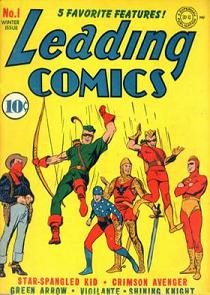 The Seven Soldiers of Victory were a major departure from the Justice Society of America. Aside from the Shining Knight’s enchanted armor and weapons, none of the Soldiers had any superhuman abilities. The skills they did have were, with the exception of the Star-Spangled Kid and Stripesy, rooted in lethal force. Both the Vigilante and the Crimson Avenger carried guns, Green Arrow and Speedy used arrows, and the Shining Knight had an intimidating broadsword. They may not have been able to turn away a full scale invasion or stop planets from colliding but they could certainly hold their own ground against more mundane problems.
The Seven Soldiers of Victory were a major departure from the Justice Society of America. Aside from the Shining Knight’s enchanted armor and weapons, none of the Soldiers had any superhuman abilities. The skills they did have were, with the exception of the Star-Spangled Kid and Stripesy, rooted in lethal force. Both the Vigilante and the Crimson Avenger carried guns, Green Arrow and Speedy used arrows, and the Shining Knight had an intimidating broadsword. They may not have been able to turn away a full scale invasion or stop planets from colliding but they could certainly hold their own ground against more mundane problems.
The team lasted for the first fifteen issues of Leading Comics. During that time they fought individual villains as well as teams of their previous foes. After a little over a year, the Seven Soldiers were unceremoniously dumped and the heroes went their separate ways back their solo tales which, for all but Green Arrow and Speedy, only lasted a few more years at best. For the most part, these seven characters were exiled into the same comic book limbo that would eventually claim almost every Golden Age superhero for at least a little while.
The Silver Age rebirth of superheroes in DC comic books that began in the late 1950’s gave way to a revival of the Golden Age heroes in the 1960’s. By the end of that decade, the major heroes from that era, who had now been established to exist on an alternate planet known as Earth-2 (to differentiate it from Earth-1, home of the current incarnation of heroes even though the other had come first), had been reinstated into continuity and some were even being published again on a regular basis.
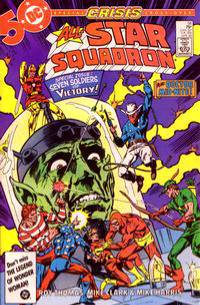 By the early 1970’s, the annual team ups of the Justice Society of America with their modern counterparts in the Justice League of America were proving to be some of the best selling issue of that title. With the one hundredth issue approaching, DC decided to create an epic storyline, spanning an almost unheard of three issues, which would unite almost every member of the JLA, the JSA, and even a few JLA reservists. This massive gathering of heroes was called upon to save the Earth from certain destruction but to do so they must rescue the Seven Soldiers of Victory!
By the early 1970’s, the annual team ups of the Justice Society of America with their modern counterparts in the Justice League of America were proving to be some of the best selling issue of that title. With the one hundredth issue approaching, DC decided to create an epic storyline, spanning an almost unheard of three issues, which would unite almost every member of the JLA, the JSA, and even a few JLA reservists. This massive gathering of heroes was called upon to save the Earth from certain destruction but to do so they must rescue the Seven Soldiers of Victory!
The Unknown Soldier of Victory explains the Seven Soldiers disappearance in the 1940’s as a result of their battle with an interstellar being called the Nebula Man. The creature was defeated with a cosmic lightening rod but the resulting explosion scattered the Soldiers throughout time and the Crimson Avenger’s sidekick Wing died in the process. Since a similar weapon is needed to defeat a menace currently threatening Earth-2, the heroes must travel through time and reunite the Seven Soldiers of Victory in the present to build it.
After three nail biting issues, the mission was completed successfully, Earth-2 was saved and the Soldiers were returned to the present day after having aged very little since the 1940’s. Even though the story was well received, the Soldiers all fell into obscurity again until the Star-Spangled Kid was tapped as part of the revival of the Justice Society in All Star Comics a few years later. The other characters would make occasional cameo appearances, including Roy Thomas’s All Star Squadron which chronicled their adventures during WWII, until the Crisis on Infinite Earths which killed off the Golden Age Green Arrow and doomed the remaining members to continuity hell!
Today, the surviving members of the team still appear from time to time, most notably in the short lived Stars and S.T.R.I.P.E. comic book which tried to sort out their troubled timeline again and as members of the JSA reserves during times of crisis. In 2005, Grant Morrison created a “Mega-Series” called Seven Soldiers of Victory that comprised seven individual miniseries bookended by two other comic books. This series attempted to give the Seven Soldiers a more mystical origin explaining that they were only one of many groups of seven heroes that had been orchestrated by time weavers to defend the Earth at various intervals. The group established by this series never actually worked together as a unit and each went back to their own lives at the conclusion.
